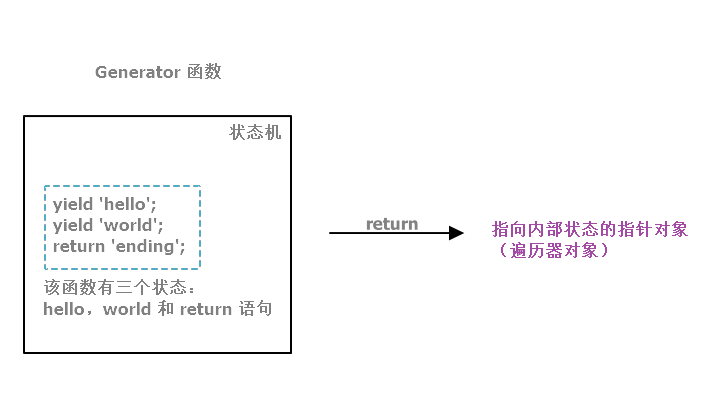ES6 - Generator生成器
基本概念#
Generator 函数有多种理解角度。语法上,首先可以把它理解成,Generator 函数是一个状态机,封装了多个内部状态。
执行 Generator 函数会返回一个遍历器对象,也就是说,Generator 函数除了状态机,还是一个遍历器对象生成函数。返回的遍历器对象,可以依次遍历 Generator 函数内部的每一个状态。
Generator 函数是一个普通函数,但是有两个特征。一是,function关键字与函数名之间有一个星号;二是,函数体内部使用yield表达式,定义不同的内部状态(yield在英语里的意思就是“产出”)。
function* helloWorldGenerator() {
yield 'hello';
yield 'world';
return 'ending';
}
var hw = helloWorldGenerator();
调用 Generator 函数后,该函数并不执行,返回的也不是函数运行结果,而是一个指向内部状态的指针对象

下一步,必须调用遍历器对象的next方法,使得指针移向下一个状态。也就是说,每次调用next方法,内部指针就从函数头部或上一次停下来的地方开始执行,直到遇到下一个yield表达式(或return语句)为止。换言之,Generator 函数是分段执行的,yield表达式是暂停执行的标记,而next方法可以恢复执行。
hw.next()
// { value: 'hello', done: false }
hw.next()
// { value: 'world', done: false }
hw.next()
// { value: 'ending', done: true }
hw.next()
// { value: undefined, done: true }
value表示yield或者return的值(如果没有return语句,则value属性的值为undefined),done表示遍历是否结束。
案例:id自增#
function* createIds(){
let index = 1;
while(true){
yield index++;
}
}
const gen = createIds();
for(var i = 0; i < 10; i++){
consolg.log(gen.next().value);
}
//1,2,3,4,5,6,7,8,9,10
参考#
作者:【唐】三三
出处:https://www.cnblogs.com/tangge/p/12122035.html
版权:本作品采用「署名-非商业性使用-相同方式共享 4.0 国际」许可协议进行许可。



【推荐】国内首个AI IDE,深度理解中文开发场景,立即下载体验Trae
【推荐】编程新体验,更懂你的AI,立即体验豆包MarsCode编程助手
【推荐】抖音旗下AI助手豆包,你的智能百科全书,全免费不限次数
【推荐】轻量又高性能的 SSH 工具 IShell:AI 加持,快人一步
· SQL Server 2025 AI相关能力初探
· Linux系列:如何用 C#调用 C方法造成内存泄露
· AI与.NET技术实操系列(二):开始使用ML.NET
· 记一次.NET内存居高不下排查解决与启示
· 探究高空视频全景AR技术的实现原理
· 阿里最新开源QwQ-32B,效果媲美deepseek-r1满血版,部署成本又又又降低了!
· Manus重磅发布:全球首款通用AI代理技术深度解析与实战指南
· 开源Multi-agent AI智能体框架aevatar.ai,欢迎大家贡献代码
· 被坑几百块钱后,我竟然真的恢复了删除的微信聊天记录!
· AI技术革命,工作效率10个最佳AI工具
2014-12-30 iis 7.5应用程序池自动停止